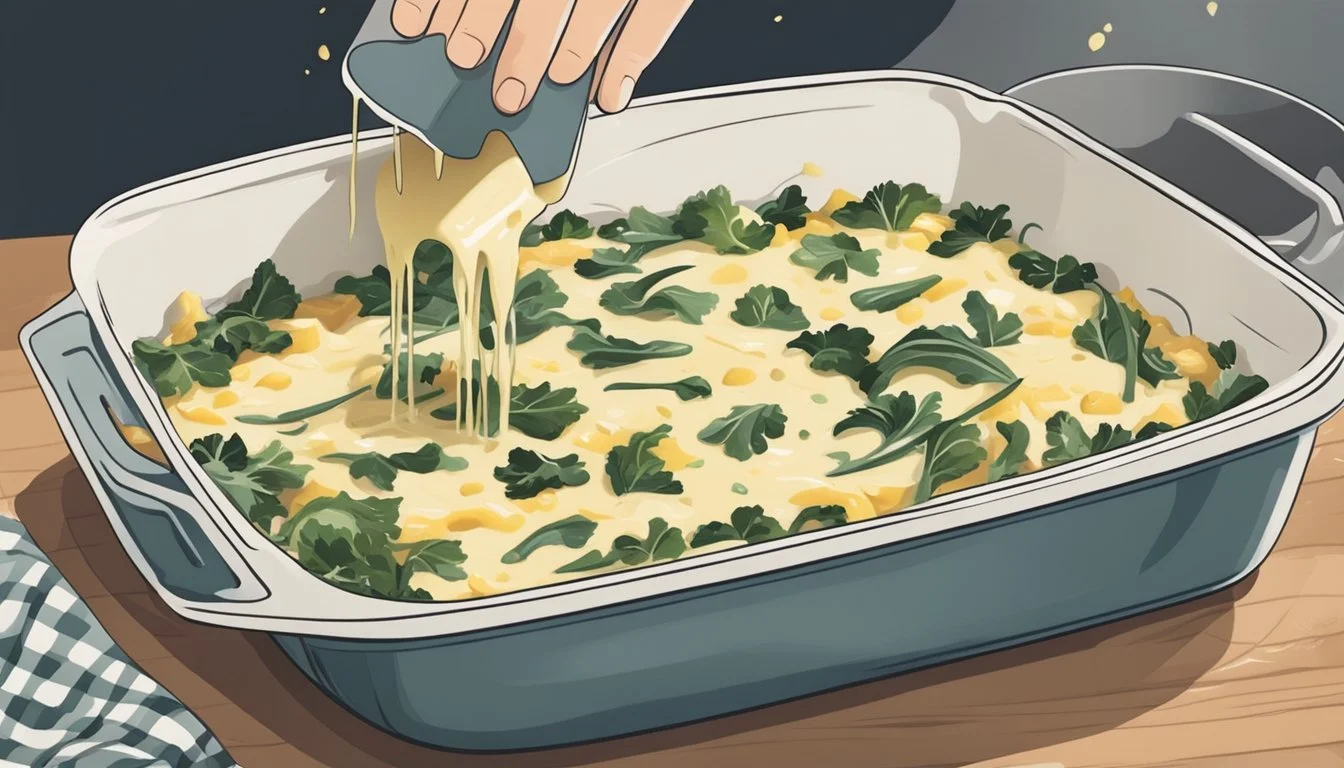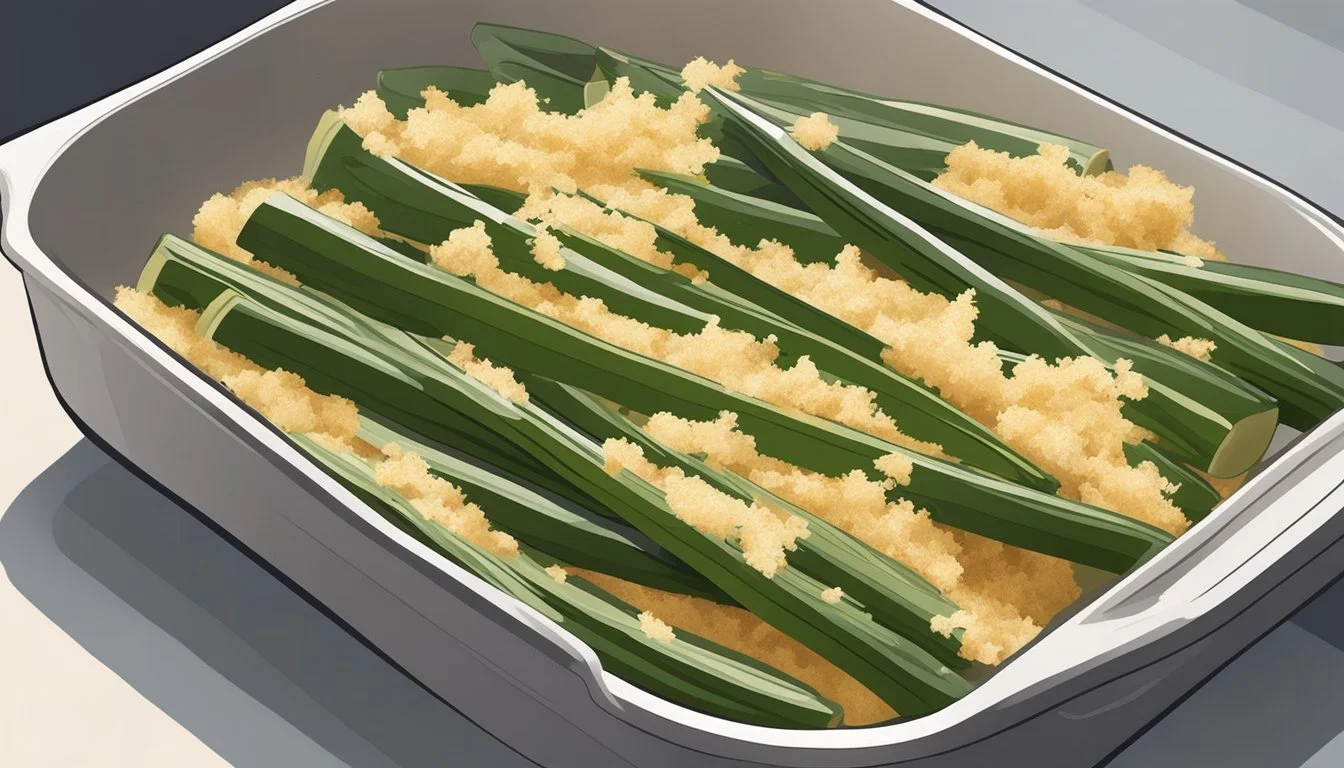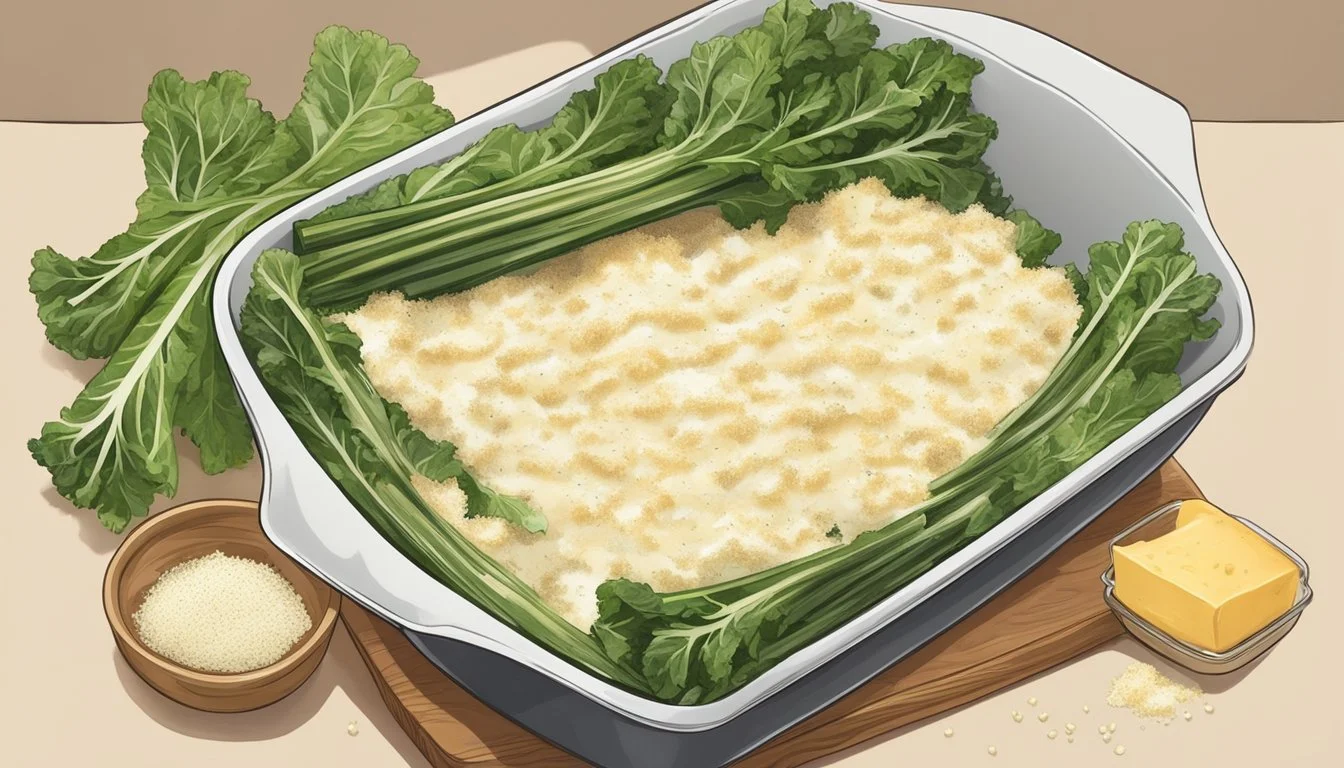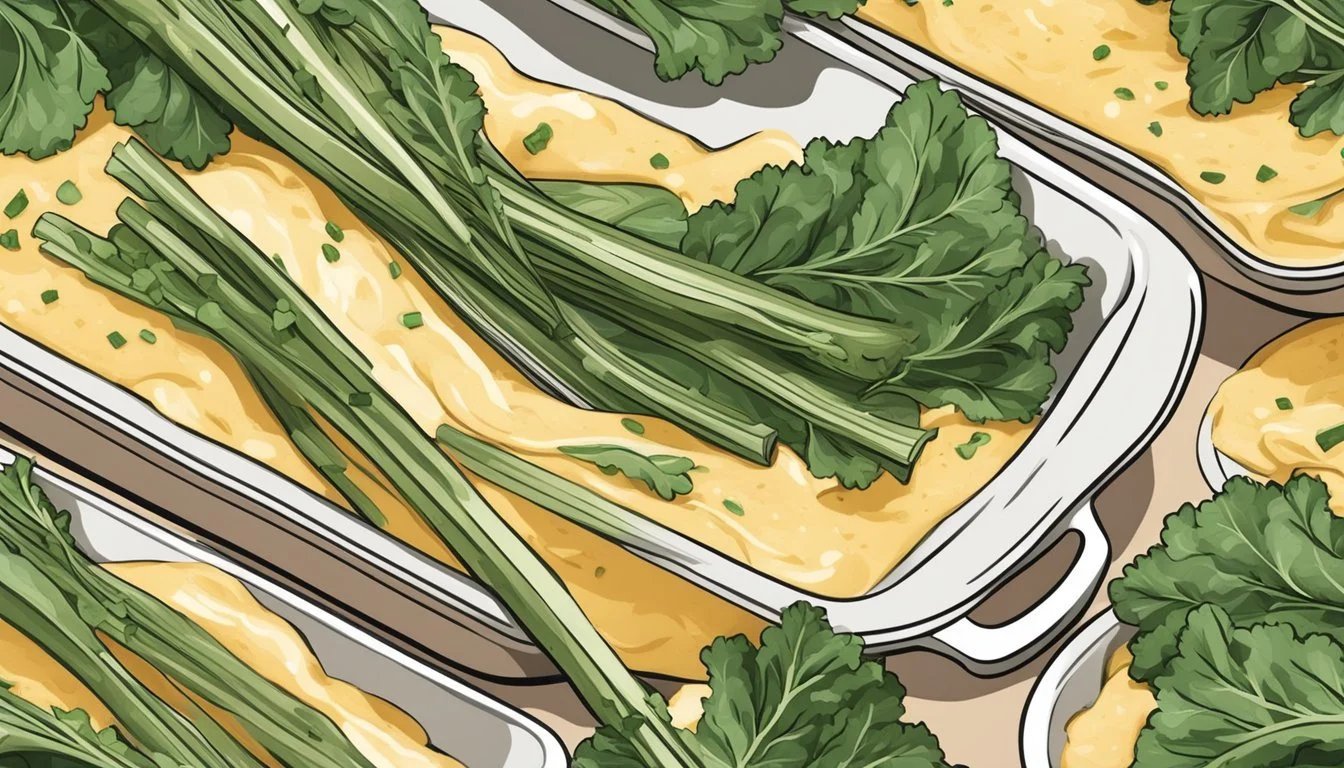Chard Stem Gratin
Transforming Leftovers into a Nutritious Delight
Chard stem gratin is a delectable side dish that marries the nutritional benefits of Swiss chard with the rich, comforting flavors of cheese and crunchy breadcrumbs. Often overlooked, the stems of Swiss chard are robust in vitamins and provide a satisfying crunch that complements the creamy texture of the gratin. This dish not only brings a pop of color to the table but also adds a layer of complexity with its distinctive taste profile, serving as an ideal accompaniment to a variety of main courses.
Preparing chard stem gratin involves baking the hearty stems under a golden crust of cheese-enhanced breadcrumbs, transforming them into a savory treat. The recipe leverages the stems' inherent crispness, which softens slightly under the heat, allowing them to absorb the flavors of the sauce they're nestled in. From the infusion of garlic to the subtlety of bay leaves, every ingredient is chosen to enhance the overall flavor of the dish, ensuring that each bite is as nutritious as it is delicious.
The versatility of the dish allows for adaptations to suit different palates, including the choice of cheeses and the option to include additional vegetables. The straightforward preparation and the mouthwatering results cement chard stem gratin's place not just as a side dish, but as a comforting staple in home cooking. Rich in vitamins and full of flavor, it's an exemplary way to enjoy a healthful ingredient often discarded during meal prep.
Background and Benefits
Chard Stem Gratin is a dish that transforms the often-overlooked stems of chard into a delectable and nutritious side. It marries the robust flavors of cheese and garlic with the crunchy texture of breadcrumbs, all while delivering essential vitamins and minerals.
Nutritional Profile
Chard stems are not only a flavorful addition to meals but also a rich source of nutrients. They are packed with vitamins such as Vitamin A and Vitamin C, both crucial for maintaining healthy vision and immune function, respectively. Furthermore, these stems are a good source of fiber, which promotes digestive health, and antioxidants, which help protect the body against oxidative stress. Here's a brief breakdown of the nutrients found in chard:
Nutrient Benefit Vitamin A Supports vision and immunity Vitamin C Promotes skin and immune health Fiber Aids in digestion Protein Essential for muscle repair Antioxidants Protects cells from damage
Incorporating chard stems into gratin not only makes use of the whole vegetable but also ensures a nutrient-dense dish that supports overall health.
Choosing the Right Ingredients
Selecting quality ingredients for Chard Stem Gratin is essential for maximizing both flavor and health benefits. Olive oil serves as a heart-healthy fat that can enhance the absorption of fat-soluble vitamins, and garlic adds not just a punch of flavor but also has its own antioxidant properties. To ensure a depth of flavor and added nutrients, choose cheeses that are both flavorful and a source of protein and calcium.
To make the most of this dish, one should season it with freshly ground pepper, which not only elevates the taste but also provides additional antioxidants. The choice of veggies, in this case, the chard stems, should be fresh and preferably organic to avoid unwanted pesticides and ensure peak vitamin content.
By being mindful of the nutritional profile and choosing the right ingredients, chard stem gratin becomes a wholesome and vitamin-packed side that complements a variety of main dishes.
Preparing the Ingredients
Proper ingredient preparation is crucial for a successful Chard Stem Gratin. The process begins with correctly handling the chard stems to ensure they cook evenly and absorb the flavors of the gratin.
Washing and Cutting the Chard Stems
One should start by thoroughly washing the chard stems under cold running water to remove any dirt or debris from the garden. Pat them dry with a kitchen towel. Next, using a sharp knife, cut the stems into uniform 2.5cm pieces. This size allows for even cooking and ensures that every bite has the perfect balance of texture and flavor.
Preparation of Additional Veggies
Additional vegetables can enhance the gratin's flavor profile and nutritional value. For example, one could thinly slice kale, chop broccoli into small florets, or dice sweet potatoes. The kale and broccoli should be blanched in boiling water for a couple of minutes to soften, while sweet potatoes may require a longer cooking time due to their density. To incorporate more green, one could slice green beans or zucchini to add freshness and a slight crunch. Each vegetable should be prepared with care, maintaining their integrity while ensuring they complement the chard stems.
Assembling the Gratin
Constructing the gratin involves careful layering of chard stems and leaves with a blend of cheeses to create a savory side dish, while incorporating herbs and seasoning to enhance the dish’s overall flavor profile.
Layering the Vegetables and Cheese
One begins the assembly by arranging the chard stems at the bottom of a buttered ovenproof dish. Over this layer, one scatters an even coating of grated parmesan cheese, known for its nutty and salty flavor profile. This process is repeated, alternating between the chard and a generous helping of cheese until the dish is filled. It's important that the final layer consists of cheese, creating a golden and bubbly crust upon baking.
Initial Layer: Chard stems
Second Layer: Grated parmesan
Repeat Layering: Ending with cheese on top
Herbs and Seasoning for Enhanced Flavor
To infuse the gratin with rich, aromatic flavors, one must season each layer with thyme, salt, freshly ground pepper, and a hint of nutmeg. The thyme offers a subtle earthiness, while the spices work together to heighten the natural flavors of the chard and balance the richness of the cheese. These seasonings should be sprinkled lightly between layers and over the final cheese topping before baking.
Herbs: A sprinkle of thyme
Seasoning: Pinch of salt, freshly ground pepper, and nutmeg for each layer
Cheese and Topping Selection
Selecting the right cheese and topping for a Chard Stem Gratin can elevate this comforting side dish into a culinary delight packed with both flavor and nutrients.
Choosing the Perfect Cheese
When one considers cheese for Chard Stem Gratin, the goal should be to identify a variety that melts well and complements the earthy tones of the chard. Provolone and Gruyère are exemplary choices for their melting properties and depth of flavor. Provolone adds a mild, smoky touch, while Gruyère offers a nutty sweetness.
Additionally, Parmesan is an invaluable inclusion. Introducing grated Parmesan contributes a savory sharpness that can penetrate through the richness of the dish, ensuring that every bite is underlined with a mature cheese essence.
Cheese Type Flavor Profile Notes Provolone Mild, slightly smoky Melts smoothly, great for layering. Gruyère Nutty, sweet Adds complexity with a creamy melt. Parmesan Sharp, savory Best used grated as a topping.
Creating a Crispy Topping
A gratin is distinguished by its golden, crunchy surface, which can be achieved by creating a breadcrumb mixture that will brown nicely in the oven. To construct a topping that provides a crispy contrast to the tender chard stems and gooey cheese beneath, one must combine breadcrumbs, a touch of softened butter, and more grated Parmesan. This blend should be evenly sprinkled over the chard and cheese mixture in the baking dish.
The ratio of breadcrumbs to cheese within the topping can be adjusted according to taste, but a good starting point is one part cheese to three parts breadcrumbs. Additionally, for a bit of variation and added flavor, some recipes may incorporate spices or herbs into the breadcrumb mixture.
Topping Ingredient Purpose Breadcrumbs Basis for the topping, provides crunch. Butter Helps the breadcrumbs to brown and crisp up. Grated Parmesan Enhances flavor, contributing to a cheesy crust.
By choosing the right cheeses and creating a well-balanced, crispy topping, the Chard Stem Gratin will not just satisfy hunger but also offer a symphony of textures and flavors.
Cooking Instructions
Preparing Chard Stem Gratin involves two main processes: baking the gratin to ensure it is thoroughly cooked and broiling for that desirable golden-brown cheesy crust.
Baking the Gratin to Perfection
First, preheat the oven to a temperature of 350 degrees F (175 degrees C). One should prepare a baking dish or casserole, typically around 30cm in diameter, by generously buttering the inside to prevent sticking. After preparing the chard stems and, in some recipes, the leaves, layer them into the dish. The gratin is then baked in the oven. Baking time can vary, but generally, one should bake until the mixture is hot and bubbly, which usually takes approximately 25 to 30 minutes.
Preheat oven: 350 degrees F (175 degrees C)
Prepare baking dish: Butter a 30cm diameter dish
Layer ingredients: Place chard stems and leaves in the dish
Bake: 25-30 minutes or until bubbly
Broiling Tips for a Golden Top
After baking, the gratin should be topped with an ample amount of cheese. Then it is placed under the broiler for a few minutes. This process requires constant vigilance to ensure that the cheese melts into a golden layer without burning. A good tip is to keep the baking dish on the middle rack and watch the cheese closely as it turns golden to achieve the perfect finish without overcooking.
Sprinkle cheese: Add a generous layer on top
Broil: Watch closely to prevent burning
Perfect finish: Aim for a golden, not burnt, cheese crust
Throughout both processes, maintaining a steady oven temperature and being vigilant during broiling are essential for a successful Chard Stem Gratin side dish.
Serving Suggestions
When serving Chard Stem Gratin, the rich and cheesy flavor complements a variety of main courses, and with the right garnish, it can elevate the visual appeal of the meal. It's an excellent dish for both lunch and dinner, providing a vitamin-packed side that is as nutritious as it is delicious.
Pairing with Main Courses
For a perfect lunch or dinner combination, Chard Stem Gratin pairs exceptionally well with:
Pasta: A light pasta dish, perhaps with a butter or olive oil base, allows the flavors of the gratin to shine.
Sausage: The hearty flavors of sausage link beautifully with the creamy gratin, especially when the sausage is flavored with herbs.
One can also consider balancing the gratin's richness with a simple roasted or grilled chicken for a satisfying dinner.
Garnishing for Visual Appeal
To garnish Chard Stem Gratin for both flavor and a display worthy of an Instagram post, consider the following:
Freshly Ground Pepper: A sprinkling adds a subtle bite and a classic look.
Parsley: Fresh parsley not only adds a pop of color but also a fresh taste that cuts through the cheese.
With these additions, the dish not only tastes great but also presents beautifully on the table.
Variations and Substitutions
Chard stem gratin can be easily adapted to accommodate dietary preferences or restrictions. These variations ensure that the dish remains delicious while catering to vegetarian, vegan, gluten-free, and low-carb diets.
Making It Vegetarian or Vegan
For a vegetarian version, one can simply ensure that the cheese and dairy products used are rennet-free. Vegan adaptations can be made by replacing dairy cheese with plant-based cheese and using nut or soy milk instead of dairy milk.
Butter replacement: Opt for olive oil or vegan butter.
Cheese replacement: Use nutritional yeast or commercially available vegan cheese.
Gluten-Free and Low-Carb Options
Those who seek a gluten-free gratin can substitute traditional breadcrumbs with gluten-free alternatives or even finely chopped nuts for added crunch.
Ingredient Gluten-Free Substitute Low-Carb Substitute Breadcrumbs Gluten-free breadcrumbs Almond meal or crushed pork rinds Flour (for sauce) Cornstarch or gluten-free flour blends Almond flour or coconut flour
For a low-carb option, focus on cheese and cream to create richness and forego the breadcrumbs altogether or replace them with a sprinkle of crushed whole grains or seeds for texture without the carb load.
Storage and Reheating Tips
When it comes to storing Chard Stem Gratin, refrigeration is key. One should store the leftovers in a shallow airtight container or wrap the dish tightly with aluminum foil or plastic wrap. The refrigerated gratin will stay fresh for up to three to five days. If one is practicing meal prep, the gratin can be portioned into servings before storing to simplify reheating.
Reheating should be done gently to maintain the gratin's creamy texture. For optimal results, one should reheat the gratin in the oven. Preheat the oven to 350 degrees Fahrenheit (175 degrees Celsius). Place the refrigerated leftovers in an oven-safe dish, and cover it loosely with foil to prevent the top from burning. Heat the gratin until it is thoroughly warmed, which typically takes about 20 minutes.
For those who are short on time, the microwave is an alternative option, even though it may slightly alter the texture. To reheat in the microwave, place a serving of gratin on a microwave-safe plate and cover it with a microwave-safe lid or vented plastic wrap. Heat on medium power in 30-second intervals, checking for even warmth.
Below is a quick reference table for storing and reheating:
Storage Method Details Duration Refrigeration Airtight container or well-wrapped 3-5 days Freezing (if needed) Freeze in covered airtight containers Not Recommended*
Reheating Method Oven Microwave Temperature/Setting 350°F (175°C) Medium power Time Covered: ~20 minutes 30-second intervals Utensils Oven-safe dish, foil Microwave-safe plate and lid
*Freezing Chard Stem Gratin is not recommended as the creamy texture may be compromised upon thawing and reheating.
Health Considerations
Chard stem gratin can be a nutritious side dish option, but consumers should be aware of allergens, dietary restrictions, and the dish's place in a balanced diet.
Understanding Allergens and Dietary Restrictions
Gluten-Free: Traditionally, gratin dishes may include breadcrumbs or roux, which contain gluten. For a gluten-free version of chard stem gratin, one must ensure that all ingredients, such as thickening agents or flour substitutes, are free of gluten.
Nut Allergy: This dish does not typically contain nuts; however, it is important for individuals with nut allergies to confirm that there has been no cross-contamination of ingredients, especially if store-bought preparations or garnishes are used.
Dairy Considerations: Chard stem gratin is often rich in cheese and cream. Those with lactose intolerance or dairy allergies should avoid traditional recipes or seek lactose-free dairy or cheese alternatives.
Balancing Your Diet
Vitamin Content: Swiss chard is known for its high vitamin content, supplying significant amounts of vitamin K and vitamin A. Including this vegetable in a gratin can contribute to a vitamin-packed meal.
Caloric Content: While nutritious, a chard stem gratin can be high in calories due to the addition of cheese, cream, and/or butter.
Cholesterol and Fat: The dairy components also contribute to the overall fat and cholesterol content. Those monitoring their cholesterol or fat consumption should adjust the recipe or portions accordingly.
Sugar Content: Chard stem gratin has a low sugar content, making it a potentially fitting choice for those managing sugar intake.
When one incorporates chard stem gratin into their diet, balance and moderation are key. It's beneficial due to its nutrient density, but it should be consumed in conjunction with a diet that accounts for its richer elements.
Pairings and Occasions
Chard stem gratin, with its rich, cheesy flavor and satisfying texture, complements many beverages and fits perfectly into various events throughout the year, particularly in the fall. Serving this dish elevates any dinner party or entertaining occasion.
Wine and Beverage Pairings
When selecting a wine to complement chard stem gratin, one should consider wines with a good balance of acidity to cut through the creaminess of the gratin. Here are some pairings:
White Wines:
Chardonnay (with oak to mirror the dish's richness)
Sauvignon Blanc (for its acidity and grassy notes)
Red Wines:
Pinot Noir (light-bodied with earthy undertones)
Grenache (fruity and soft, pairs well with the cheese)
For non-alcoholic options, a sparkling mineral water or a tart apple cider can provide a refreshing contrast to the gratin's richness.
Events and Seasonal Opportunities
Chard stem gratin is particularly suited for:
Dinner Parties: Its elegant presentation and warm, comforting nature make it an excellent side dish that impresses guests.
Entertaining: Easy to prepare in large quantities, it suits buffet-style service or plated meals.
Fall Gatherings: The hearty characteristics of the gratin align well with the cooler weather and seasonal produce of the fall.
Whether it's a laid-back gathering or a formal event, chard stem gratin is versatile enough to be a highlight of the dining experience.











